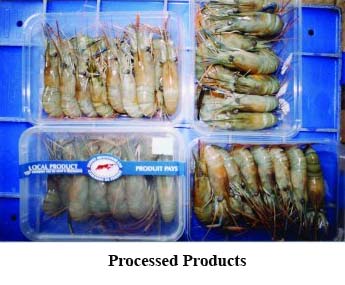Post Harvest Handling
In general, the value of harvested product depends on its quality. Speed during and after harvesting, getting the prawns on ice and out of the sun, and care in handling to prevent physical damage, will all reap valuable dividends.
Handling prawns to be sold fresh : If you intend to sell your prawns fresh (instead of selling them alive or frozen) you will need to keep them very cool. You should not place live prawns straight onto ice; this results in a slow decline in body temperature, causes stress, and accelerates the deterioration process, which occurs after death. To kill a batch of 50 kg of prawns, for example, immerse them in 50 l of water and 80 kg of ice for 30 minutes. Finally, you should wash them in chlorinated water (5 ppm active chlorine). After killing, remove prawns from the cold water and immediately place them in isothermal boxes, with alternate layers of ice and prawns, placing ice in the first and last layers.
Handling prawns to be sold frozen : If prawns are to be sold within 5 days of harvest, which is considered to be their maximum practical refrigerated shelf life, freeze them immediately. Freezing at temperatures below -10°C is essential; storage at -20°C or below is recommended; storage at -30°C is ideal. To avoid physical damage to the muscle structure of the prawns, it is recommended that the freezing temperature passes from -1°C to -5°C as rapidly as possible (not more than 2 hours). This decreases the production of ‘drip' (leak) at the moment of thawing, and keeps the prawns looking and tasting the same as before freezing. If you freeze them more slowly, it will cause large ice crystals to form between the cells of the animals and increase ‘drip'. Keeping prawns frozen on-farm is generally not good practice, except on very large farms where specialist equipment has been installed.


